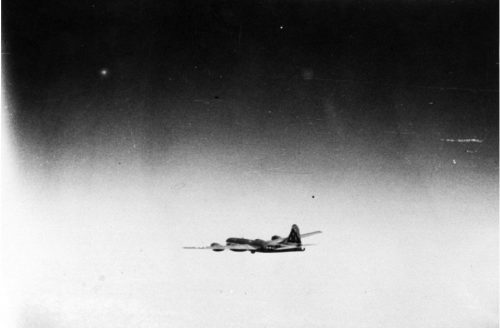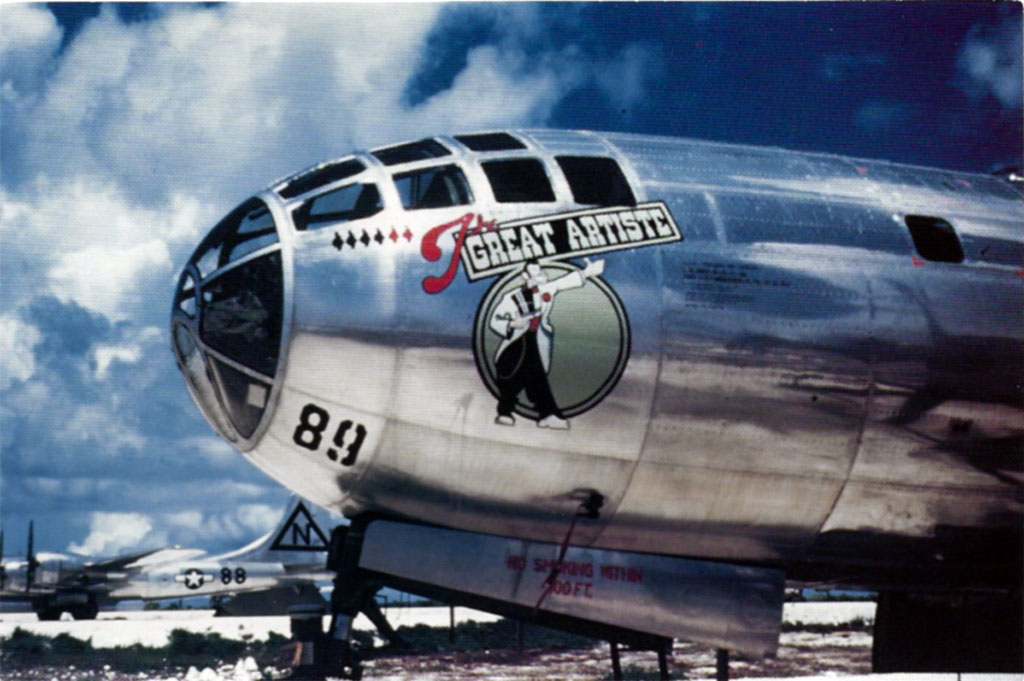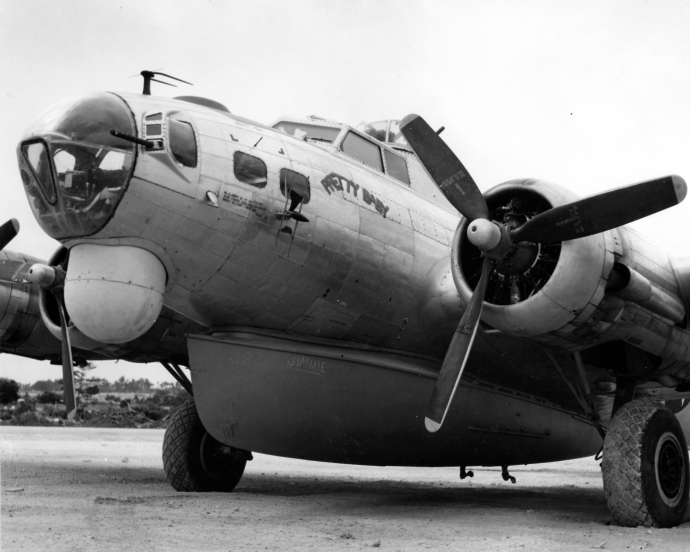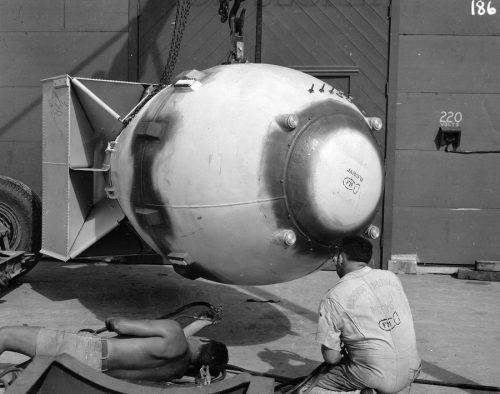This column is adapted from a recent e-mail from Ryan Crierie that is reposted here with his permission. It is the tale of how almost everything that could go wrong, did go wrong, on the day Nagasaki was nuked.
This is a U.S. military map of the radioactive fall out caused by the nuclear strike on Nagasaki. See the pattern of black dots upper right.
And make sure to read through the P.S. There is a historical “What If” stinger waiting for you there.
The Apocalypse Factory: Plutonium and the Making of the Atomic Age by Steve Olson is a very interesting book; as it focuses on plutonium production at Hanford as well as the Nagasaki mission. Olson integrated a lot of stuff that had been written before (such as Sweeney’s book War’s End: An Eyewitness Account of America’s Last Atomic Mission in the 1990s)

You all know that Tibbets and Sweeney elected to start the mission with a bad fuel pump in the rear bomb bay reserve tank; leaving Bockscar with 6,400 gallons of usable fuel instead of 7,000. (total fuel loaded was 7,250 gallons).
Gross takeoff of Bockscar was 155,000 lbs; some 15,000 lbs over the post-war 140,000 lb maximum take off weight (MTOW) set for the B-29; even with Bockscar being 6,000 pounds lighter than the standard B-29, with no armor carried and all guns except two .50 caliber tail guns removed.

What’s not generally known by the public is that there was a storm between Tinian and Japan.
During preflight planning, they estimated they’d have to fly at 17,000 ft (instead of 8,000 ft) to get above the storm, burning more fuel that way.
Even this wasn’t enough as per Sweeney in his 1995 memoir:
“But even at 17,000 feet the ride had its dips and jumps….About an hour into the flight, we were skating along the edge of the storm front and the ride had smoothed out.”
So you can imagine flying at 3 to 4 AM local time in the middle of a storm, with an armed atomic bomb bouncing around in the bomb bay.

At around 7 AM local or four hours into their flight; while climbing to 30,000 feet; Ashworth reported that the warning light on the fuse monitoring system was flashing; indicating that the firing circuit was closed and some or all of the bomb fuzes had activated.
As Sweeney ran it through:
- Contact Fuze — not a problem unless we crash.
- Barometric/Radar Fuzes – Not a problem unless we go below 1,890 feet
- Timing Fuze — We only have 43 seconds or less to fix.
Barnes and Ashworth opened up the monitoring box and found that someone on the ground had put two switches in the wrong position. When this was fixed, the light went out.
By 7:45 AM local, they’d reached the rendezvous point at 30,000 feet and were burning 500 gallons of fuel per hour, or 8.33 gallons a minute.
They met up with Fred Bock, flying The Great Artiste (Instrument Plane) within moments, but didn’t encounter the third plane — Big Stink (Photo Plane).

Unbeknownst to them, Big Stink was at the rendezvous point, but flying at 39,000 feet, instead of 30,000 feet; and due to radio silence, they weren’t able to inform the others they were there as well.
Despite Tibbets ordering them to wait only 15 minutes for late planes, and then leave immediately for the target no matter what, Sweeney orbited for 40 to 45 minutes before breaking off to the target.
Meanwhile the commander of Big Stink, becoming increasingly uneasy, broke radio silence and radioed “Has Sweeney Aborted?”
Due to atmospherics, the first word was lost in transmission, and back at Tinian, only “Sweeney Aborted” was heard. When General Tom Farrell heard this, he ran outside and threw up.
Due to the misheard “abort”, the Air Sea Rescue laid in for the mission was accordingly canceled. If Bockscar had to ditch in the ocean, there would be no (quick) rescue.

At 9:45 AM local time after seven hours in the air, Bockscar approached Kokura, nearly an hour later than the planned 8:45 AM bombing time.
This bombing time (Hiroshima had been bombed at 8:15 AM Local) was not by random chance.
In December 2016, I located some documents that basically said that in June 1945, plans were being made for a mass gas attack on Tokyo at 8 AM with either 21,600 x 500 pound Phosgene-filled gas bombs or 5,400 x 1,000 pound Phosgene-filled gas bombs in the event that theater commanders got the go-ahead for Chemical Warfare. [1]
That specific bombing time was chosen as it was the time when the most people would be concentrated in the city center.
Unfortunately for Sweeney, an hour’s delay had caused the weather over Kokura to change, with clouds rolling in from the ocean. Additionally, the day before, more than 200 B-29s had firebombed Yawata, and the smoke from that burning city was now drifting over Kokura.
Sweeney made a failed visual bomb run on Kokura and swung around for a reattack.
Japanese flak then began to bracket Bockscar, and per the tail gunner’s report:
“Wide but altitude is perfect!”
To counter this, Sweeney went up to 31,000 feet to confuse the fusing solution, but the Japanese began to walk the flak onto Bockscar:
“This damn flak is right on our tail and getting closer.”
Once again, a failed bomb run was made and Sweeney swung around for a third attempt at a visual bomb run. At this point, the radar operator reported that about ten Japanese fighters were climbing upwards. Also generally around this time, their ECM/RCM operator reported increased activity on the Japanese fighter director bands.
Sweeney went up to 32,000 feet for the third run, and despite this; the flak continued to be close to the plane, causing it to jump.
The third run, failed as the others did before, and the flight engineer reported that the fuel state was now critical. They had enough (1,500~ gallons) to get to the secondary (Nagasaki) and do one run — and even then they’d fall short by about fifty miles of the closest American airfield at Okinawa.
This is where accounts differ.
Sweeney called Ashworth forward and said “We haven’t got the time or the fuel for more than one run. Let’s drop it by radar. I’ll guarantee we come within five hundred feet of the target.”
In some accounts, Ashworth says that he’ll think it over, before responding:
“We’ll have to risk getting the bomb back to Okinawa. Our orders were that we weren’t to make a radar drop. I’ll have to carry out orders.”
But at around five minutes from Nagasaki, supposedly, Ashworth says:
“I’ve changed my mind, Chuck. We’ll let it go over Nagasaki, visually, radar, or what have you.”
As they approached Nagasaki from the northwest, they found that it was 80 to 90% obscured by cloud cover; so they started a radar bomb run with Jim van Pelt using the radar to try and make a drop at the mission aimpoint, in the commercial district.
The bomb bay doors opened at T-30 seconds to drop, and at only T-25 seconds to go; Kermit Behan called out that “I’ve got it! There’s a hole in the clouds. I can see the target.”
Downtown Nagasaki — where the mission aimpoint was — was covered in clouds, but there was a hole in the clouds on the Urakami valley.
Sweeney simply said: “You own it.” and Kermit Behan on the fly selected the Urakami valley, or more specifically, the area between the Mitsubishi sports field in Hamaguchi-machi and the Mitsubishi Steelworks and Arms Factory in Mori-machi as the new aimpoint and dropped FAT MAN.
It exploded over a tennis court 500 to 600 meters north of the new aimpoint, only 0.34 miles off course, rather than the more commonly cited “two miles”.

Per the Japanese in a website run by the Nagasaki local government:
“If it had exploded over the aiming point according to Field Order No.17, the atomic bomb would have devastated the city center and administrative core, including the government office district, downtown shopping core, residential districts to the south and east, the railroad and port facilities, ships and vessels in the harbor, and the Mitsubishi factories on the opposite shore. The breakdown of administrative functions, especially at the prefectural and municipal government levels, would have severely hampered subsequent rescue and relief efforts and greatly compounded the impact of the atomic bombing.”
What’s really interesting about all this is that Kermit Behan at a whim changed Nagasaki from “aimpoint specifically targeting civilians” to an aimpoint that would more predominantly strike the military targets in the Urakami valley.
The Mitsubishi Nagasaki Arms Factory was rendered unusable (107,462 m2 out of 133,314 m2 floor space pretty much destroyed);
The Mitsubishi Nagasaki Steelworks was hit hard, with 57 out of 626 machine [tools] destroyed, and the remainder rendered unuseable; and 69% of the employees on duty that day becoming casualties.
Another interesting fact is that Mitsubishi Nagasaki Arms Factory was working on the Type-5 torpedo, a small 28 cm torpedo that could be launched from small motorboats or submarines designed for the decisive battle to defend the homeland. [2]
The first prototypes had been finished in June 1945, but in ten test firings, the torpedo hadn’t worked as intended. (This was kind of a big problem as the Type-5 had already been tooled up for mass production).
On the morning of 9 August 1945, the engineer in charge of the Type 5 torpedo reported to Yokouchi Giichiro, Chief of the Design Section that the Type-5 had finally worked in tests the previous day, and that a final test would be done that day (9 August) to validate the solutions to the bugs in the torpedo.
As Yokouchi Giichiro recounted: “That was the last time I saw Mr. Matsuoka.”
Elsewhere, Kojima Noboru, the author of the book TennÅ (“Emperor”), describes a Cabinet meeting that took place at 2:30 PM on 9 August:
“The atomic bombing of Nagasaki was reported at the Cabinet meeting. On the basis of information obtained from a captured American pilot, War Minister Anami Korechika reported that: ‘Atomic bombs generate a flash of light and blast simultaneously using electricity rather than gunpowder. Their explosive power is equivalent to that of 2,000 B-29 bombers carrying 36 500-pound bombs. The effect of atomic bombs is significant when the sky is clear, while not so in case of rain. The reinforcement of shelters with logs will provide sufficient protection… The Americans have another 100 atomic bombs and are capable of producing three per month, but these bombs are not durable.’ Anami said that he based his report on statements by First Lieutenant Marcus McDilda of the 7th U.S. Army Air Corps. Aside from the reference to explosive power, none of the information was correct, but Anami’s report passed without arousing doubt because no one at the meeting had any idea about the nature of atomic bombs.”
What I find totally absurd is that 1LT McDilda’s absurd lies were right on the money for production rate — on 13 August 1945, General Hull and Colonel Seaman had a talk about the atomic bombs:
Colonel Seaman –
“The biggest gap will be between the one now and the one for the first part of September. After that, I would say approximately one every ten days.”[3]
As an aside, it it very likely that LT McDilda’s lies saved his life, since it was later discovered that 50 USAAF POWs in Osaka, the camp in which he had been held before being transferred for further questioning, had been executed shortly after the broadcast of the Japanese surrender. (https://www.forces-war-records.co.uk/blog/2015/08/11/lieutenant-marcus-mcdilda-captured-tortured-interrogated)
-End-
P.S.

So here’s why they sprayed “JANCFU” on the nose of the bomb case.
Per a Facebook Post (https://www.facebook.com/nukecompendium/posts/193569939465588) by Nuke Compendium:
“Some of the high-explosive (HE) case components were delivered to the Fat Man assembly facility to begin a trial assembly of the spherical HE case and ballistic case for the “Fat Man” combat bomb. There, under the direction of Lt. John Hopper and Henry Linschitz, other members of the HE team started to assemble the HE blocks onto the forward polar cap and then to build up a portion of the HE sphere. At the pre-assembly shop in the Tech Area they soon discovered that they were in trouble. The forward and rear parts of the armor-plate ellipsoidal case were warped out-of-round. As a result, the bolt holes for attaching the case segments to the equatorial flange of the spherical HE case could not be aligned and the bolts could not be passed through the three parts. Evidently the ellipsoidal case parts had not been inspected properly before they were shipped form W-47 (Wendover AAF).
The assembly crew searched through the remaining crates of ellipsoidal case parts but could not find any others made of armor-plate. The Batch 5 shipment of the Bowery Logistics included additional armor plate cases, but that batch had not yet arrived at Tinian. They tried beating on the available parts with a maul in an attempt to bend them into shape, but that turned out to be useless. Finally, desperate, we used a two-man electric drill in an attempt to enlarge the bolt holes. The drill-bit jammed in a hole, and the drill threw Art Machen off the case to the floor and made a sever gash in his leg. The attempt to enlarge the holes was a failure. The assembly crew had run out of options and eventually it was decided to use the cases made of ordinary steel.”
How is this for a counter-factual alternate history:
At Kokura on their third bomb run, there’s a brief break in the clouds enabling visual bombing by Bockscar.
FAT MAN is dropped…and the Japanese flak that’s been trailing Bockscar and catching up to them…shifts fire to FAT MAN itself.
The entire reason for the (weighty) armored cases on LITTLE BOY and FAT MAN was to protect the insanely valuable bomb from enemy action on the way down, to ensure it would detonate.
Because of deadlines; the Project ALBERTA assembly team on Tinian had to use practice steel cases to meet the assembly deadline.
Regular steel does not have the ballistic qualities of armor plate.
How well do you think FAT MAN would work if a Japanese AA shell exploded next to it on the way down?
It’s likely that the contact fuze and barometric fuze in FAT MAN would work, ensuring that the RDX high explosives inside it fire.

However, due to the complex nature of the cabling wrapping around the plutonium implosion sphere, it’s highly likely that FAT MAN would have “fizzled” since several explosive blocks would not have fired.
That’s the best case.
Worst case, it hits the ground intact and sprays bomb parts and plutonium over that tennis court.
Notes & Sources:
[1] Ryan Crierie had run down a copy of the secret report titled “A Study of the Possible Use of Toxic Gas in Operation Olympic,” that Thomas B. Allen & Norman Polmar excerpted in their article “The Most Deadly Plan” in the January 1998 issue of USNI Proceedings Magazine. The report was commissioned by General George C. Marshall as a back up plan in case the atomic bombs failed to get the Japanese to surrender. The gassing of Japanese urban centers in the plan called for would have resulted in five million Japanese civilian casualties. The proper description of this plan was genocide.
[2] The web site navweaps.com states only two prototypes of the 28 CM (11-inch) Type 5 Torpedo were made before the end of WW2. These prototypes used a five-cylinder swashplate engine, massed at 230 kg. (507 lbs.) with a Type 97 60 kg (132 lbs.) warhead. They had a maximum range of 1,500 meters. suicidality short by 1945 standards, but that wasn’t an issue in Ketsu-Go era Japan. See: http://www.navweaps.com/Weapons/WTJAP_WWII.php
[3] Sources vary on whether First Lieutenant Marcus McDilda was a B-29 bomber or a P-51 fighter pilot. One other lie that he told turned out to be so was that the third bomb was aimed for Tokyo. It was. The relevant passage from a Aug. 14 1945 message in the Spaatz papers reads “BECAUSE OF GREAT POTENCY TARGETS SHOULD WHERE PRACTICABLE BE AT LEAST 3 MILES ON A SIDE. TARGETS WITH PARTIALLY BURNED OUT AREAS HAVING LARGE REMAINING POPULATION AND SOME INDUSTRY OFFER GREAT POSSIBILITIES FOR PSYCHOLOGICAL EFFECTS. WE CONSIDER THE “SCARE RADIUS” TO BE AT LEAST 10 MILES.” This is one of the possible aim points for the 3rd atomic bomb.


Thanks, Mr. T. Very interesting history. It certainly makes the point about the “Fog of War”.
It is also interesting how the bombing of Nagasaki figures larger than the firebombing of Dresden — even though both were very destructive and killed somewhere in the range of 10 – 20% of the people in the respective cities. The anti-nuclear agents got in early, and now the West is wasting money on birdwhackers & solar panels while Russia & China are building carbon-free nuclear power plants.
The loss of life in war is always regrettable. But I recall the story of the US pilot wheeling his bomber over a burning Japanese city and asking rhetorically — Just who did you think you were messing with anyway?
Well researched Trent. Question: Was Tibbets involved in both the Hiroshima flight and the Nagasaki flight? What you wrote concerning bomb production collaborates what I have read – that contrary to conventional history, they it would have been a long time after Nagasaki before another bomb was ready, there would have been no shortage.
I read in the event the Japanese didn’t surrender after Nagasaki, another 3 targets were on the list (including the lucky Kokura)
The biggest problem with target selection was due to the success of fire bombings it was difficult to find undestroyed targets.
Tibbets was the unit commander, he assigned all the crews. Here’s an interview where he goes into some detail, quite interesting.
https://www.youtube.com/watch?v=qG2n3EmNtqY
Part 2:
https://www.youtube.com/watch?v=UelE357z58M
DIdn’t know about the re-targeting decision, really interesting info there. Thanks.
On “what if” — wondering if Japanese AA could depress fast enough to his the bomb in free fall. IIRC the Japanese did not have proximity fuses, so a hit would be luck or aim, and you gotta aim somewhat close for luck to take over.
The reason the cables in the picture of the plutonium bomb look the way they do isn’t because they were too lazy to dress them neatly. They all had to be the exact same length so that the signal that triggered the explosives would be simultaneous. They also had to avoid any sharp bends. The whole thing was very fragile compared to the gun type that needed the highly enriched uranium that was in very short supply. They didn’t know what the exact margin was between a partial detonation and a fizzle that would be called a dirty bomb today.
We have switched all of our weapons over the the implosion type for the contradictory seeming reason that it’s very easy to prevent them from working. This made the permissive safety system easier to implement.
Highly enriched uranium is still difficult to get while it’s much easier to make a bomb from it once you have it. Thus all the Iranian centrifuges.
I’m no AA expert, and maybe I’ve missed part of the story, but I’m wondering if the Japanese had the situational awareness at the time to have responded to Fat Man–high-flying photo recon flights with a few aircraft were pretty common, and did they know at Nagasaki by then what had destroyed Hiroshima?
Cousin Eddie
>>Well researched Trent
Ryan did a wonderful job here. He has a real feel for researching this subject.
>>Was Tibbets involved in both the Hiroshima flight and the Nagasaki flight?
Yes, he was. The choice of planes and the ignoring of the fuel line issues with Bockscar were in his lane.
>> it would have been a long time after Nagasaki before another bomb was ready
One bomb was ready in the Marianas save for the plutonium pit General Groves sat upon. It it had left on 12 Aug 1945 on the scheduled C-54. Tokyo would have been nuked on the morning of 14 August 1945.
It’s one of the little known ironies that General Groves action on 11-12 August likely saved as many Japanese lives in Tokyo as the two earlier bombs in Hiroshima & Nagasaki took.